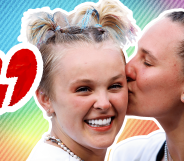IDAHOBIT 2024: Microaggressions harm LGBTQ+ people – here’s how to spot and prevent them

Microaggressions are actions that negatively impact a person or specific group of people, like the LGBTQ+ community. (Getty Images/PinkNews)
Microaggressions are actions that negatively impact a person or specific group of people, like the LGBTQ+ community. (Getty Images/PinkNews)
As we mark the International Day Against Homophobia, Biphobia and Transphobia (IDAHOBIT), it’s important to recognise how the occasional “cheeky” chat and little quips could be considered as microaggressions and be quite harmful to LGBTQ+ people.
Not all examples of homophobia, transphobia and biphobia are blatant. The truth is that words matter, and some people may not realise they are showing prejudice because they could be unknowingly engaging in microaggressions.
Microaggressions are actions, words and behaviours that negatively target a person or a specific group of people, such as the LGBTQ+ community.
People may not realise they are making a microaggressive comment or action and may not mean harm to anyone. But microaggressions can be very hurtful to those who experience them.
Types of microaggressions
Microaggressions exist primarily in three ways: verbal, behavioural and environmental.
Verbal microaggressions are words and comments that are stigmatising and hurtful, even though they were said without that intent. For example, asking a lesbian couple “which one of you is the guy in the relationship?” reinforces the stereotype that all romantic relationships must follow a heteronormative model with a masculine and feminine partner.
This line of questioning, regardless of the intent, assumes that there needs to a “masculine” person in the relationship, regardless of sexual orientation. It also invalidates the couple in question because they don’t fit the “norm,” possibly leading them to feel their relationship is not as valid as others.
A behavioural microaggression is acting in a discriminatory or hurtful way, usually fuelled by an unconscious bias: for example, a waiter in a restaurant ignoring a trans person and serving a cis person instead. This behaviour is exclusionary and also can make the transgender individual feel unseen and unimportant, potentially reinforcing their feeling of being different or outside the norm.
An environmental microaggression is when subtle discrimination occurs in society. A good example would be a higher education institution’s marketing materials not reflecting the college’s diversity in faculty and students.
When marketing materials only showcase a particular group (often the majority), it sends a message that the institution caters primarily to that group. Students from under-represented groups might feel they wouldn’t be welcome or wouldn’t fit in on campus.

How to avoid committing microaggressions
Changing behaviours can be quite difficult, especially as microaggressions are a form of learned bias. However, it can be done.
Faced with being called out on a microaggression, one should strive for an open and receptive approach. Rather than defensiveness or dismissal, the situation becomes an opportunity for empathetic listening. Acknowledging one’s role and taking responsibility for any underlying bias is key.
The moment presents a chance for growth and learning. A commitment to further education and a willingness to adapt behaviour paves the way to avoiding similar missteps in the future. By taking these steps, one demonstrates a willingness to learn and fosters a more respectful environment for all.

